Related Research Articles

Our Lady of Guadalupe, also known as the Virgin of Guadalupe, is a Catholic title of the Blessed Virgin Mary associated with four Marian apparitions to Juan Diego and one to his uncle, Juan Bernardino reported in December 1531, when the Mexican territories were part of the Spanish Empire.
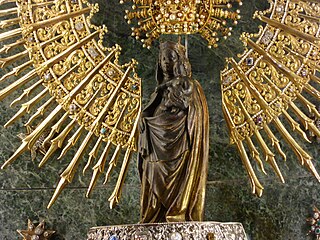
Our Lady of the Pillar is the name given to the Blessed Virgin Mary in the context of the traditional belief that Mary, while living in Jerusalem, supernaturally appeared to the Apostle James the Greater in AD 40 while he was preaching in what is now Spain. Those who adhere to this belief consider this appearance to be the only recorded instance of Mary exhibiting the mystical phenomenon of bilocation. Among Catholics, it is also considered the first Marian apparition, and unique because it happened while Mary was still living on Earth.
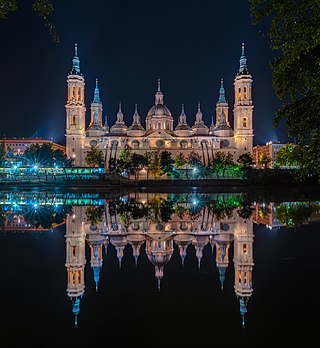
The Cathedral-Basilica of Our Lady of the Pillar is a Catholic church in the city of Zaragoza, Aragon. It is dedicated to the Blessed Virgin Mary under the title of Our Lady of the Pillar, praised as "Mother of the Hispanic Peoples" by Pope John Paul II. It is reputed to be the first-ever church dedicated to Mary.

Jane the Virgin is a 2002 Venezuelan telenovela written by Perla Farías and produced by RCTV. It was distributed worldwide by RCTV International.
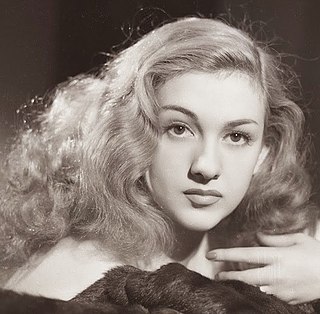
María Amparo Rivelles Ladrón de Guevara was a Spanish actress.
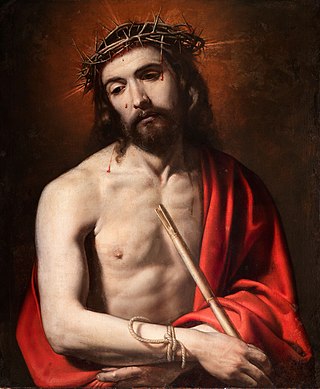
Antonio Fernández Arias was a Spanish painter of the Baroque period.
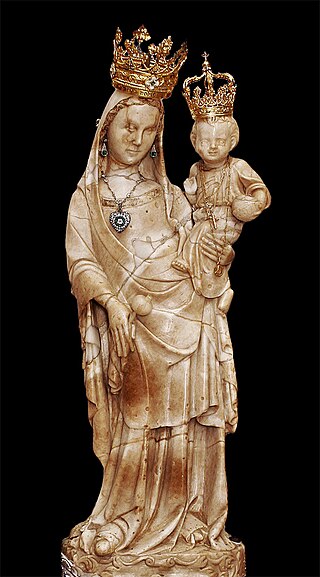
The Virgin of Miracles or Saint Mary of La Rábida is a religious Roman Catholic image venerated at the La Rabida Monastery in the city of Palos de la Frontera.

Juan Diego Cuauhtlatoatzin (1474–1548), also known simply as Juan Diego, was a Nahua peasant and Marian visionary. He is said to have been granted apparitions of Our Lady of Guadalupe on four occasions in December 1531: three at the hill of Tepeyac and a fourth before don Juan de Zumárraga, then the first bishop of Mexico. The Basilica of Our Lady of Guadalupe, located at the foot of Tepeyac, houses the cloak (tilmahtli) that is traditionally said to be Juan Diego's, and upon which the image of the Virgin is said to have been miraculously impressed as proof of the authenticity of the apparitions.
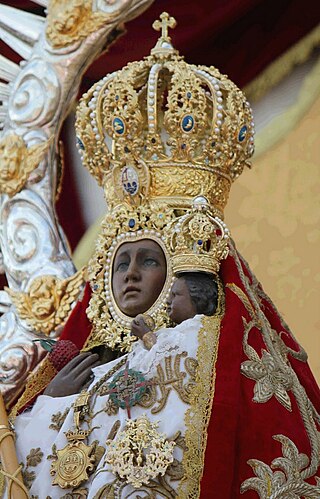
Our Lady of Cabeza is a Marian apparition and statue of the Madonna and Child, whose cult is centered at the Basilica of Nuestra Señora de la Cabeza, located in the Natural Park of the Sierra of Andújar, 32 km north of the city of Andújar, Spain. A Black Madonna, she is known popularly as La Morenita.
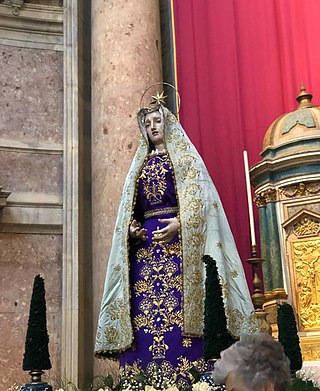
Our Lady of Solitude is a title of Mary, mother of Jesus and a special form of Marian devotion practised in Spanish-speaking countries to commemorate the solitude of Mary on Holy Saturday. Variant names include Nuestra Señora de la Soledad, Maria Santisima, Nuestra Señora Dolorosisima de la Soledad, and Virgen de la Soledad.

The Sanctuary of Our Lady of Graces of Onuva, located in the municipality of La Puebla del Río, province of Seville, region of Andalusia, in Spain, is a Marian shrine that marks the exact place where a young man of his name Jesús José Cabrera claimed to have witnessed several apparitions of the Blessed Virgin Mary and two appearances of Jesus Christ himself.
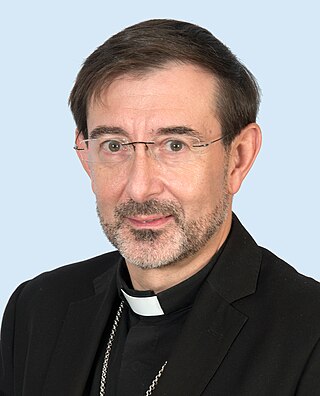
The Ordinariate for the Faithful of Eastern Rite in Spain is an Ordinariate (pseudo-diocese) for all non-Latin Catholic faithful living in Spain who belong to the particular Churches sui iuris of any Eastern rite immediately subject to the Holy See.

Our Lady of the Rosary of San Nicolás is, in Catholicism, a title of veneration of the Blessed Virgin Mary associated with a reported private revelation to Gladys Quiroga de Motta, a middle-aged housewife, beginning in the 1980s in the city of San Nicolás de los Arroyos, Argentina. Quiroga said that she was tasked with promoting devotion to the Mother of God under this title, with an emphasis on key passages in the Bible and a particular mystical stellar symbolism.
José Arranz Arranz, was a Spanish priest, Canon of Burgo de Osma Cathedral between 1986 and 1998 and founder of the bank Caja Rural in Soria.

The Monumento a la Virgen de la Paz is a colossal statue honoring Mary. Completely made out of concrete, it is located 11 kilometres (6.8 mi) southwest of the city of Trujillo in Venezuela. At 46.72 metres (153.3 ft) tall it is the 48th tallest statue in the world, the tallest statue in South America and the second-tallest in the Americas, the fourth-tallest statue depicting a woman in the world, and the second tallest statue of Mary in the world. It is 16 metres (52 ft) across, with a base that is 18 metres (59 ft) deep, and weighs 1,200 tonnes.

Mónica García Gómez is a Spanish anesthesiologist and politician, current coordinator and spokesperson of the political party Más Madrid in the Madrilenian Assembly. She was an elected deputy during the X legislature of the Madrilenian Assembly under the Spanish political party Podemos, and is currently a deputy in the XI legislature as part of Más Madrid. Since 2015, García has combined her political work with her job in health care, with a 50% reduction in working hours. She was appointed Minister of Health in the third government of Pedro Sánchez following the 2023 Spanish general elections.

The church of the Pilgrim Virgin is a scallop-shaped Roman Catholic chapel located in the city of Pontevedra, in Spain, along the route of the Portuguese Way of St. James.

The Sanctuary of the Apparitions is a Catholic convent and sanctuary located in Pontevedra, Spain. According to Sister Lúcia, it was here that the child Jesus and the Virgin Mary appeared to her in 1925-1926 and revealed to her the First Saturdays Devotion.

José Cobo Cano is a Spanish prelate of the Catholic Church. He has been serving as the archbishop of Madrid since his installation on 8 July 2023. He previously served as auxiliary bishop of that archdiocese. Pope Francis made him a cardinal on 30 September 2023.
References
- 1 2 El Correo (19 August 2012). "Muere Amparo Cuevas, la 'vidente de El Escorial'" . Retrieved 19 August 2012.
- ↑ Prestservi. "Nuestra Señora de El Escorial" (in Portuguese). Archived from the original on 28 September 2013. Retrieved 20 August 2012.
- 1 2 Virgen de los Dolores. "Breve Historia" . Retrieved 20 August 2012.
- ↑ Apocalipsis Mariano. "Las Aparicones y Mensajes de El Escorial". Archived from the original on 2012-09-19. Retrieved 20 August 2012.
- ↑ ABC (19 August 2012). "Madrid Muere Amparo Cuevas, la supuesta "vidente" de El Escorial" . Retrieved 19 August 2012.
- 1 2 Amparo Cuevas, una vida de luces y sombras El correro. 25.08.12 - 07:34 - LUIS RABOSO | MADRID
- ↑ Prado Nuevo (19 August 2012). "Obra de la Virgen de El Escorial". Archived from the original on 3 September 2012. Retrieved 19 August 2012.